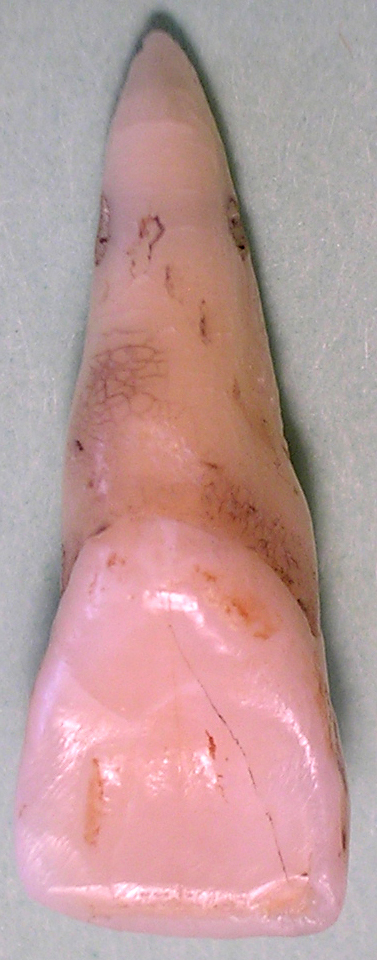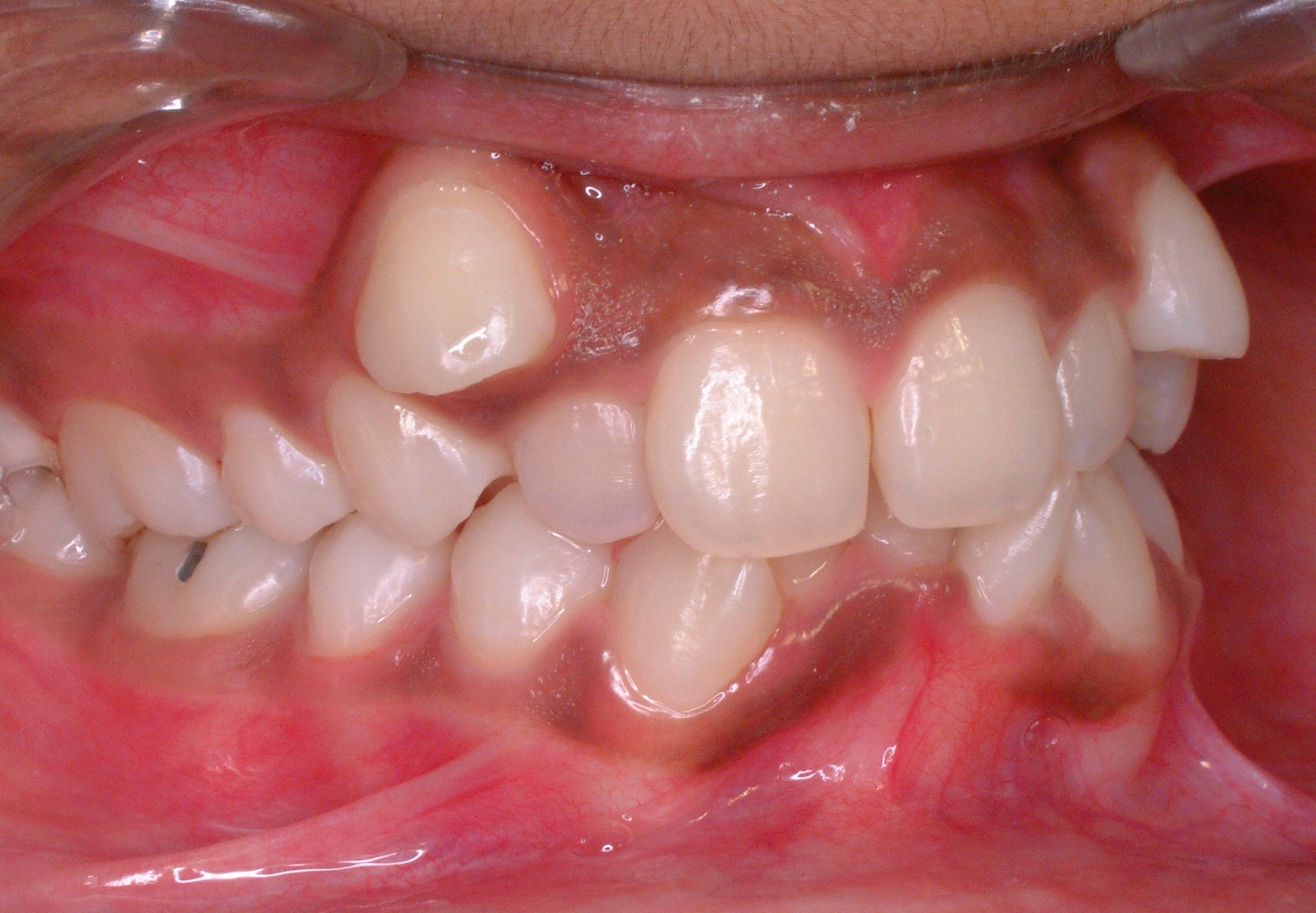|
Dens Evaginatus
Dens evaginatus is a rare odontogenic developmental anomaly that is found in teeth where the outer surface appears to form an extra bump or cusp. Premolars are more likely to be affected than any other tooth. It could occur unilaterally or bilaterally. Dens evaginatus (DE) typically occurs bilaterally and symmetrically. This may be seen more frequently in Asians (including Chinese, Malay, Thai, Japanese, Filipino and Indian populations). The prevalence of DE ranges from 0.06% to 7.7% depending on the race. It is more common in men than in women, more frequent in the mandibular teeth than the maxillary teeth. Patients with Ellis-van Creveld syndrome, incontinentia pigmenti achromians, Mohr syndrome, Rubinstein-Taybi syndrome and Sturge Weber syndrome are at a higher risk of having DE. Signs and symptoms It is important to diagnose DE early and provide appropriate treatment to help prevent periodontal disease, caries, pulpal complications and malocclusion. It occurs on ... [...More Info...] [...Related Items...] OR: [Wikipedia] [Google] [Baidu] |
Dentistry
Dentistry, also known as dental medicine and oral medicine, is the branch of medicine focused on the teeth, gums, and mouth. It consists of the study, diagnosis, prevention, management, and treatment of diseases, disorders, and conditions of the mouth, most commonly focused on dentition (the development and arrangement of teeth) as well as the oral mucosa. Dentistry may also encompass other aspects of the craniofacial complex including the temporomandibular joint. The practitioner is called a dentist. The history of dentistry is almost as ancient as the history of humanity and civilization with the earliest evidence dating from 7000 BC to 5500 BC. Dentistry is thought to have been the first specialization in medicine which have gone on to develop its own accredited degree with its own specializations. Dentistry is often also understood to subsume the now largely defunct medical specialty of stomatology (the study of the mouth and its disorders and diseases) for which reas ... [...More Info...] [...Related Items...] OR: [Wikipedia] [Google] [Baidu] |
Rubinstein–Taybi Syndrome
Rubinstein–Taybi syndrome (RTS) is a rare genetic condition characterized by short stature, moderate to severe learning difficulties, distinctive facial features, and broad thumbs and first toes. Other features of the disorder vary among affected individuals. These characteristics are caused by a mutation or deletion in the CREBBP and/or EP300 gene located on chromosome 16. People with this condition have an increased risk of developing noncancerous and cancerous tumors, leukemia, and lymphoma. This condition is sometimes inherited as an autosomal dominant pattern and is uncommon. Many times it occurs as a de novo (not inherited) occurrence. It occurs in an estimated 1 in 125,000-300,000 births. Presentation Facial features (A), left hand and feet showing broad thumb and big toes (B, C) and X-ray of both hands showing short broad thumbs (D). (Limb Malformations & Skeletal Dysplasia) Rubinstein–Taybi syndrome presents itself from birth, and is usually hallmarked by delayed ... [...More Info...] [...Related Items...] OR: [Wikipedia] [Google] [Baidu] |
Cusp Of Carabelli
The cusp of Carabelli, or Carabelli's tubercle, or ''tuberculum anomale'' of Georg Carabelli is a small additional cusp at the mesiopalatal line angle of maxillary first molars. This extra cusp is usually found on the secondary maxillary first molars and is rarely seen on primary maxillary second molars even less likely on other molars. This cusp is entirely absent in some individuals and present in others in a variety of forms. In some cases, the cusp of Carabelli may rival the main cusps in size. Other related forms include ridges, pits, or furrows. This additional cusp was first described in 1842 by the Hungarian Georg Carabelli (Carabelli György), the court dentist of the Austrian Emperor Franz. The cusp of Carabelli is a heritable feature. Kraus (1951) proposed that homozygosity of a gene is responsible for a pronounced tubercle, whereas the heterozygote shows slight grooves, pits, tubercles or bulge. Later studies showed that the development of this trait is affected by m ... [...More Info...] [...Related Items...] OR: [Wikipedia] [Google] [Baidu] |
Agenesis
In medicine, agenesis () refers to the failure of an organ to develop during embryonic growth and development due to the absence of primordial tissue. Many forms of agenesis are referred to by individual names, depending on the organ affected: * Agenesis of the corpus callosum - failure of the Corpus callosum to develop *Renal agenesis - failure of one or both of the kidneys to develop * Amelia - failure of the arms or legs to develop *Penile agenesis - failure of penis to develop *Müllerian agenesis - failure of the uterus and part of the vagina to develop *Agenesis of the gallbladder - failure of the Gallbladder to develop. A person may not realize they have this condition unless they undergo surgery or medical imaging, since the gallbladder is neither externally visible nor essential. __TOC__ Eye agenesis Eye agenesis is a medical condition in which people are born with no eyes. Dental & oral agenesis *Anodontia, absence of all primary or permanent teeth. *Aglossia, absence o ... [...More Info...] [...Related Items...] OR: [Wikipedia] [Google] [Baidu] |
Pathosis
A disease is a particular abnormal condition that negatively affects the structure or function of all or part of an organism, and that is not immediately due to any external injury. Diseases are often known to be medical conditions that are associated with specific signs and symptoms. A disease may be caused by external factors such as pathogens or by internal dysfunctions. For example, internal dysfunctions of the immune system can produce a variety of different diseases, including various forms of immunodeficiency, hypersensitivity, allergies and autoimmune disorders. In humans, ''disease'' is often used more broadly to refer to any condition that causes pain, dysfunction, distress, social problems, or death to the person affected, or similar problems for those in contact with the person. In this broader sense, it sometimes includes injuries, disabilities, disorders, syndromes, infections, isolated symptoms, deviant behaviors, and atypical variations of structure and fu ... [...More Info...] [...Related Items...] OR: [Wikipedia] [Google] [Baidu] |
Pulp Necrosis
Pulp necrosis is a clinical diagnostic category indicating the death of the pulp and nerves of the pulp chamber and root canal of a tooth which may be due to bacterial sequelae, trauma and chemical or mechanical irritation. It is often the end result of many cases of dental trauma, caries and irreversible pulpitis. In the initial stage of the infection, the pulp chamber is partially necrosed for a period of time and if left untreated, the area of cell death expands until the entire pulp necroses. The most common clinical signs present in a tooth with a necrosed pulp would be a grey discoloration of the crown and/or periapical radiolucency. This altered translucency in the tooth is due to disruption and cutting off of the apical neurovascular blood supply. Sequelae of a necrotic pulp include acute apical periodontitis, dental abscess or radicular cyst and discolouration of the tooth. Tests for a necrotic pulp include: vitality testing using a thermal test or an electric pulp test ... [...More Info...] [...Related Items...] OR: [Wikipedia] [Google] [Baidu] |
Tubercle (bone)
In the skeleton of humans and other animals, a tubercle, tuberosity or apophysis is a protrusion or eminence that serves as an attachment for skeletal muscles. The muscles attach by tendons, where the enthesis is the connective tissue between the tendon and bone. A ''tuberosity'' is generally a larger tubercle. Main tubercles Humerus The humerus has two tubercles, the greater tubercle and the lesser tubercle. These are situated at the proximal end of the bone, that is the end that connects with the scapula. The greater/lesser tubercule is located from the top of the acromion laterally and inferiorly. The radius has two, the radial tuberosity and Lister's tubercle. Ribs On a rib, tubercle is an eminence on the back surface, at the junction between the neck and the body of the rib. It consists of an articular and a non-articular area. The lower and more medial articular area is a small oval surface for articulation with the transverse process of the lower of the two vertebrae whic ... [...More Info...] [...Related Items...] OR: [Wikipedia] [Google] [Baidu] |
Occlusal Trauma
Occlusal trauma is the damage to teeth when an excessive force is acted upon them and they do not align properly.Bibb, CA: Occlusal Evaluation and Therapy in the Management of Periodontal Disease. In Newman, MG; Takei, HH; Carranza, FA; editors: ''Carranza’s Clinical Periodontology'', 9th Edition. Philadelphia: W.B. Saunders Company, 2002. pages 698-701. When the jaws close, for instance during chewing or at rest, the relationship between the opposing teeth is referred to as occlusion. When trauma, disease or dental treatment alters occlusion by changing the biting surface of any of the teeth, the teeth will come together differently, and their occlusion will change.Hinrichs, JE: Occlusal The Role of Dental Calculus and Other Predisposing Factors. In Newman, MG; Takei, HH; Carranza, FA; editors: ''Carranza’s Clinical Periodontology'', 9th Edition. Philadelphia: W.B. Saunders Company, 2002. page 192. When that change has a negative effect on how the teeth occlude, this may cau ... [...More Info...] [...Related Items...] OR: [Wikipedia] [Google] [Baidu] |
Temporomandibular Joint
In anatomy, the temporomandibular joints (TMJ) are the two joints connecting the jawbone to the skull. It is a bilateral synovial articulation between the temporal bone of the skull above and the mandible below; it is from these bones that its name is derived. This joint is unique in that it is a bilateral joint that functions as one unit. Since the TMJ is connected to the mandible, the right and left joints must function together and therefore are not independent of each other. Structure The main components are the joint capsule, articular disc, mandibular condyles, articular surface of the temporal bone, temporomandibular ligament, stylomandibular ligament, sphenomandibular ligament, and lateral pterygoid muscle. Capsule The articular capsule (capsular ligament) is a thin, loose envelope, attached above to the circumference of the mandibular fossa and the articular tubercle immediately in front; below, to the neck of the condyle of the mandible. Its loose attachment to th ... [...More Info...] [...Related Items...] OR: [Wikipedia] [Google] [Baidu] |
Cingulum (tooth)
In dentistry, cingulum (Latin: girdle or belt) refers to an anatomical feature of the teeth. It refers to the portion of the teeth that forms a convex protuberance at the cervical third of the anatomic crown. It represents the lingual or palatal developmental lobe of these teeth.Ash, Major M. and Stanley J. Nelson. ''Wheeler’s Dental Anatomy, Physiology, and Occlusion.'' 8th edition. 2003. . In zoology and palaeontology, cingulum refers to this feature only in the upper teeth. When this occurs in the lower teeth it is called the cingulid A cingulid is a term used when describing teeth, it refers to a ridge that runs around the base of the crown of a lower tooth (the equivalent on the upper teeth is the cingulum). The presence or absence of a cingulid is often a diagnostic featur .... References Teeth {{dentistry-stub ... [...More Info...] [...Related Items...] OR: [Wikipedia] [Google] [Baidu] |
Malocclusion
In orthodontics, a malocclusion is a misalignment or incorrect relation between the teeth of the upper and lower dental arches when they approach each other as the jaws close. The English-language term dates from 1864; Edward Angle (1855-1930), the "father of modern orthodontics", popularised it. The word "malocclusion" derives from ''occlusion'', and refers to the manner in which opposing teeth meet ('' mal-'' + ''occlusion'' = "incorrect closure"). The malocclusion classification is based on the relationship of the mesiobuccal cusp of the maxillary first molar and the buccal groove of the mandibular first molar. If this molar relationship exists, then the teeth can align into normal occlusion. According to Angle, malocclusion is any deviation of the occlusion from the ideal. However, assessment for malocclusion should also take into account aesthetics and the impact on functionality. If these aspects are acceptable to the patient despite meeting the formal definition of ... [...More Info...] [...Related Items...] OR: [Wikipedia] [Google] [Baidu] |


.jpg)

